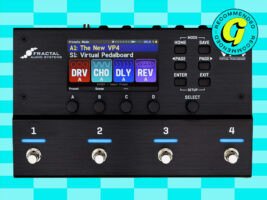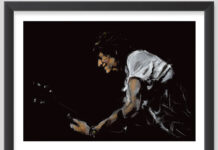
Fractal Audio VP4 Virtual Pedalboard review: “you could sell your pedal collection and replace it with this”
$699/£749, fractalaudio.com
Back in 2015, partly in response to those players reluctant to give up their tube amps but who wanted access to the vaunted suite of top quality effects available on their flagship product – the hugely popular Axe-Fx 2 – Fractal Audio developed the FX8: a multi-effects pedal that contained all their effects, but none of their amps and cabs.
READ MORE: Chase Bliss Brothers AM review: “it could easily be the last drive pedal you ever buy”
Prior to this, the only way to access Fractal’s effects alone was to run the Axe-FX 2 through the effects loop of your amp – something that the likes of Steve Vai, Satriani and Mike Keneally were doing at the time – so it made sense to create a standalone product.
The FX8 was another hit for the brand, offering a plethora of all the usual delays, reverbs, modulations and drives in a comfortably compact package – no less than Guthrie Govan was a fan.
But that was a decade ago now, and in the ever-evolving world of high-end DSP effects, that’s an awful long time. Fractal has updated most of its line-up in the intervening 10 years, and now it’s the turn of the FX8, which is being replaced in the lineup by a unit that arrived at the tail end of last year, dubbed the VP4.
Fractal Audio VP4 – what is it?
Like its predecessor, the VP4 is a high-end multi-effects unit that is derived from the flagship Fractal product of the time – in this case that means the Axe-Fx 3. Now, the Axe-Fx 3 is no spring-chicken itself – it’s been around since 2018 – but as with all modern modelling tech, the brand has been regularly supporting the product with new firmware updates, tones and tweaks ever since, so it’s bang up to date in that regard.
As people seem less and less inclined to make use of football pitch-sized pedalboards, it seems that modern manufacturers and users place footprint above a lot of things. So the VP4 is considerably smaller than the FX8 – it’s tiny in comparison really – but that does mean you’re now working with half the number of footswitches.
Just four footswitches here also means that you can only run four effects simultaneously, but as with the FX, you do get the full suite of pre- and post-amp effects including drives, delays, modulators, reverbs, and everything in between.
We also have a myriad of connection possibilities covering buffered analogue bypass, SPDIF digital I/O, MIDI I/O, and USB audio/MIDI capabilities. All the fun of the fair that you’d expect from a premium effects unit here in 2025.
Fractal Audio VP4 – do I place it in my effects loop or in front of the amp?
All the connectivity, plus the various pre- and post-amp effects on offer does present an interesting question out of the door… where does it live?
The easiest option is to run VP4 effects through the front of the amp, but what if you just want your drives up the front and your effects loop is the preferred destination for modulation and echo/reverb pedals?
The VP4’s various ins and outs allow you to do this courtesy of what’s known as the ‘four cable method’. This – surprise, surprise – uses four cables to connect the VP4 to the front of the amp and its effects. This enables us to run some effects before the amp (generally drives, pitch shifters, and wahs) and others through the amp’s effects loop – most commonly delay and modulation effects.
Unfortunately, this method is notorious for generating ground loop noise, which is a nightmare to eliminate. Some manage it using a hum-eliminator, but in my experience this slightly affects the tone in specific frequency ranges. We’ll see if the VP4 is similarly afflicted.
Image: Press
Fractal Audio VP4 – usability
The most important thing with any deep and involved multi-effects unit is the ease of navigation. The unit’s colour screen makes this a pretty straightforward process, but if you prefer to do your preset-sculpting on a desktop editor, the Fractal one is both easy to use, stable and in-depth – though you’ll have to connect it to your laptop via USB-C.
There are 50 presets loaded on board, all named to give some sort of indication of the sonic services they provide i.e. ‘Austin Stevie’. Loading up the default patch gives us four effects or ‘blocks’: a drive, chorus, delay, and reverb. Navigating to the routing menu we can select how we’d like to run each of these effects: ‘pre’ (front of amp) or ‘post’ (effects loop). We select the ‘1 pre’, ‘3 post’ option as we want to run the overdrive in front of the amp and the rest through the effects loop.
Once you’ve set up the preset, you can determine how you want the footswitches to behave. Currently I’m in ‘preset’ mode which means I’m able to use them to select different presets (banks of four pedals). There are a total of 104 presets available in 26 banks, which can be navigated by holding down one of the footswitches. Each preset has its own noise gate, EQ and volume levels, meaning that you can set each differently.
There is also the ‘scenes’ option which allows us four different configurations of each block. For example, in my current Scene A I have a TS808 in the drive block, a small hall in the reverb block, and a tape delay in the delay block.
Switching to Scene B (there’s also C and D) can utilise a different overdrive in the drive block and change to a plate reverb in the reverb block. Each scene can be configured differently and assigned to one of the four footswitches.
My preference, however, is to use the ‘pedal’ view whereby you can engage each effect using the corresponding footswitch.
Fractal Audio VP4 – sounds
To get things started, I set the VP4 up in four-cable mode and upon releasing the amp from standby mode, the first big surprise is, well… silence. As alluded to above, interference and ground loop hum is the bane of this kind of setup, but not so here. I can’t emphasise what a big deal this is for touring and gigging guitarists, and it’s certainly a first for me.
One of the biggest bugbears of multi-effects units is often the drive sounds – going all the way back to the first Line 6 POD, people have always complained that digital recreations don’t get the feel and response of a drive pedal right, and despite huge strides in technology in the last 20-plus years, that perception often holds.
The VP4 clearly wants to change that perception as it’s stocked with emulations of pretty much every classic pedal imaginable, from the Boss DS-1 to modern boutique stunners like the Vemuram Jan Ray.
Now, as something of a drive obsessive, I am fortunate enough to own a great many of these modelled pedals, so why not A/B them to see if this thing really does have the juice in the dirt stakes?
First up is the venerable Boss SD-1 – a bona-fide classic that pairs well with my EL34-powered Suhr Badger – and first impressions are impressive. It’s driving the amp in the same manner of an SD-1 – boosting the mids, smoothing out some of the harsher high-end frequencies and focussing the low end.
Engaging my own SD-1 with the same settings, the VP4 sounds very slightly brighter; however by turning its tone down a touch and adding a tiny fraction more gain the sound is near-identical.
Next up is the DOD Overdrive/Preamp 250, and it’s the same result – the tiniest of adjustments on the VP4 once again leads to a sound that’s almost impossible to differentiate. Another surprise is the notable lack of hiss when engaging the VP4 drive compared to its analogue counterpart.
It really is an impressive feat to accurately model analogue gear, retain its qualities but eliminate or diminish the more extraneous noise that none of us want – and it does it with so many classic pedals here. But enough about overdrives! What are the other effects like?
Delays and reverbs are our next stop and there’s a huge selection of both with the VP4. The tape delays are particularly rewarding, and I can see it in real-time replacing my new UA Orion tape delay pedal, with the ‘worn tape’ preset proving especially inspiring.
There are over 70 different reverbs with multiple parameters that allow you to dial in preferred pre-delay, decay, mix, etc. There are some hidden delights on board too such as the mysteriously named ‘Recording studio C’, which is a tight shimmery reverb ostensibly based on some very expensive analogue studio gear.
Fractal Audio VP4 – should I buy one?
Although Fractal will forever be synonymous with its incredible digital amp modelling capabilities, those in the know have been equally as desirous of their effects suite. The VP4 represents their most compact and inexpensive method of providing them for use with tube amps.
Onboard are literally thousands of pounds worth of unerringly accurate models of the greatest overdrive pedals ever created, along with studio quality modulation, pitch shifting, compressors and other effects.
The VP4 offers more than that though – it provides this accuracy without the addition of unwanted noise. And I’m not talking of the analogue noise that many of us have affection for – no, it’s the hiss from a drive pedal or the hum from the four-cable method.
While it’s obviously not a cheap thing, it starts to feel generous when you calculate what you’re getting for your money – you could easily sell a handful of pedals and take a dive with this, even if you’re wary of multi-effects in general.
And if you are apprehensive about taking the plunge into a modeller, my advice is simple – try one of these, you won’t be disappointed. It’s the best digital multi-effects unit I’ve ever used.
Fractal VP4 – alternatives
Much like the VP4, Line 6’s HX Effects ($549.99/£499) was designed to usurp your pedal collection and integrate with your favourite amp. Slightly larger than the VP4 but featuring eight footswitches and the ability to run nine effects simultaneously, its 213 different effect models make it vast in scope.
Not quite as guitar-centric is the Eventide H90 ($899/£799) a company who have led the way for decades with studio quality reverb, pitch shifting, and delays. The H90 packages many of these classics in a very petite unit including reverb and delays galore with some superb modulation and industry-defining pitch shift capabilities.
It would be remiss not to mention one of the first manufactures of multi-effects pedals, Boss, who still provide a huge range, one of which is their flagship GT-1000CORE ($659.99/£599) which features the full suite of their famous effects and access to virtual amps and cabs too, allowing up to 24 simultaneous effects blocks.
The post Fractal Audio VP4 Virtual Pedalboard review: “you could sell your pedal collection and replace it with this” appeared first on Guitar.com | All Things Guitar.
Source: www.guitar-bass.net












